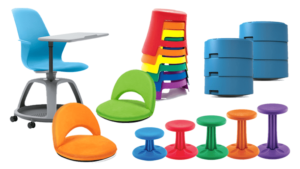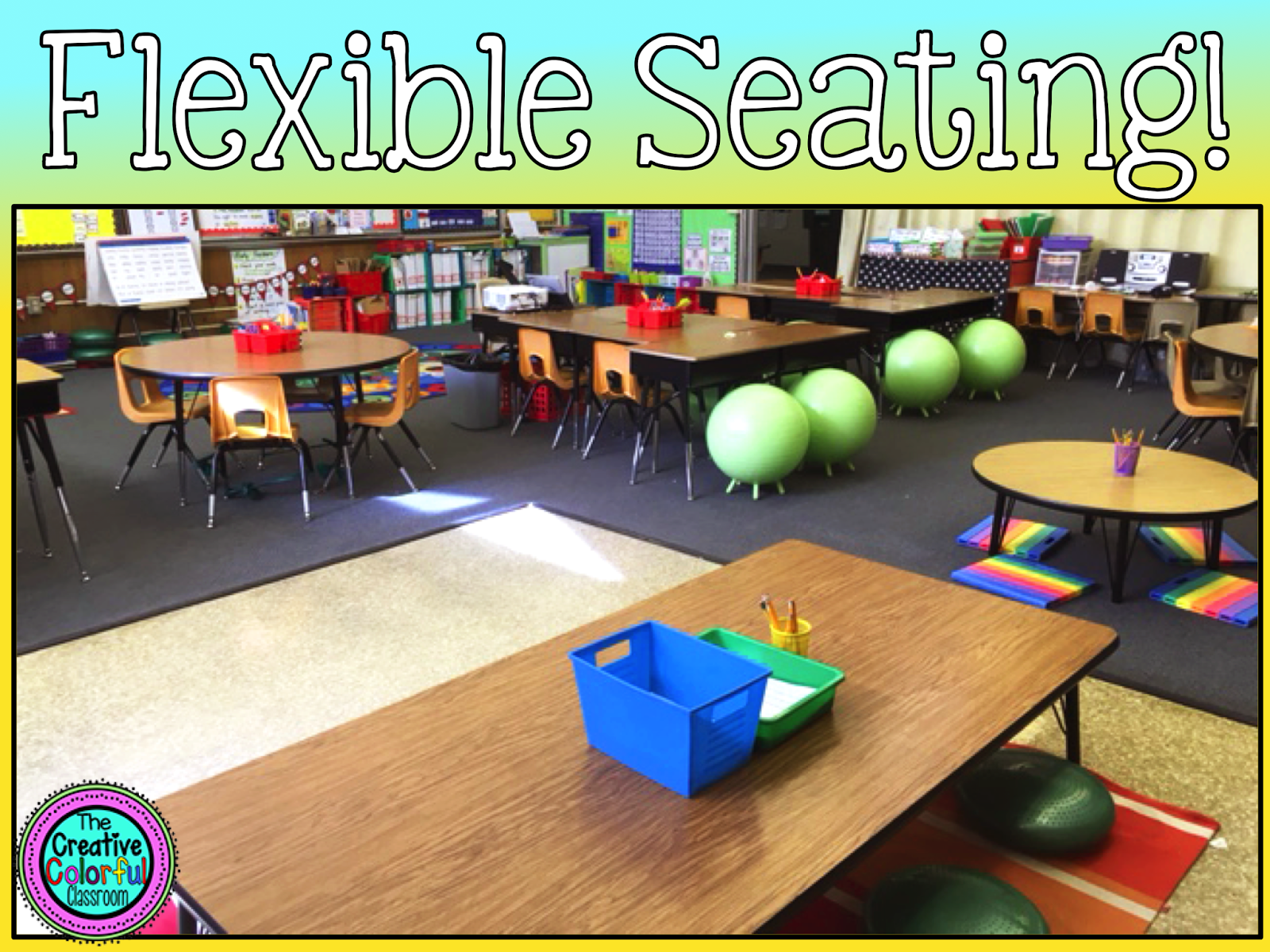Student Contributor: J.Waleske
 Flexible seating is the practice of allowing and providing many seating options for students. This means having different types of seats like yoga balls, chairs, couches, stools, etc. This also means given students the freedom to choose where they sit.
Flexible seating is the practice of allowing and providing many seating options for students. This means having different types of seats like yoga balls, chairs, couches, stools, etc. This also means given students the freedom to choose where they sit.
Flexible seating is a strategy that my current mentor teacher uses, there are many options for the student to sit on including chair, stools, crates, yoga balls, and couches. The students have assigned seats where they keep all their materials and supplies, however, they are allowed to freely move to other locations to a place that they feel most comfortable with. This tool can be used to prevent behavior problems that coincide with fidgeting. However, it is necessary to talk about the procedures for using the flexible seating as some student may not be able to handle it and it can be more distracting rather than helpful. We need to teach students to make the right choice for their seating and encourage them to pick a seat that they are most successful in.
 This tool is place in the preventative phase because I think that it is a useful tool that can be used in preventing disruptive outburst and behavior due to the buildup energy. Flexible seating works similar to fidget toys and allow students to fidget by bouncing on a ball, standing, balancing on a wobble chair. The tool fits into student centered management because they must make appropriate choices for where to sit and be most productive. This tool may require some collaborative management to create procedure for when using the various seats and what occurs is the class or individuals are using them irresponsibly.
This tool is place in the preventative phase because I think that it is a useful tool that can be used in preventing disruptive outburst and behavior due to the buildup energy. Flexible seating works similar to fidget toys and allow students to fidget by bouncing on a ball, standing, balancing on a wobble chair. The tool fits into student centered management because they must make appropriate choices for where to sit and be most productive. This tool may require some collaborative management to create procedure for when using the various seats and what occurs is the class or individuals are using them irresponsibly.
More Information –
Tool Source: Melissa Krall
https://www.prodigygame.com/blog/flexible-seating-classroom-ideas/



4th grade
25 students
Suburban
My placement already has flexible seating in the classroom, so the set-up was done for me. Students can sit at a table of their choosing with seating options of pillows on the floor with a low table, milk crates with cushions at a half circle table, tall stools at tall tables, or short stools at desk level tables, and a square table with standard chairs. I also did not have to teach any of the rules to their flexible seating, as this was done at the beginning of the year when they set up their classroom contract. This fits into the preventative phase because teaching in a flexible seating classroom causes fewer distractions during lessons. Students are able to fidget, or relax at their seats while being hands free, and this reduces the need for students to preoccupy themselves with other items near them.
7th grade
About 90 students throughout the entire day
Suburban
Flexible seating was already a strategy that my mentor teacher had in place when I started my placement. Due to COVID all the desks in the classroom are in rows facing forward. However, students can start class in their assigned seat and then move to a different seat in the classroom where they feel comfortable. Students also have the choice to work in the “den” in their grade level halls, which has round tables and desks. Flexible seating has been successful in the classroom I am in because students are able to work with peers they feel comfortable with. This allows for a more collaborative approach to learning and students seem more confident in the classroom when they have the freedom to move to places where they feel comfortable. Students understood that their role in flexible seating is to choose a seat where they can be most successful, eliminate distractions, and work collaboratively to learn the content. I think one adjustment that could be made would be to provide more options for seating. Since my placement classroom only has standard desks, I think it would be beneficial to incorporate pillows, or exercise balls, etc. when COVID protocols allow.
Grade Level: 3rd
Number of Students: 26
Demographics: Suburban
My placement has had flexible seating within the classroom since the beginning of the year. Thankfully my mentor has had flexible seating within her classroom for many years now, therefore I did not have to set this up. We call this choice seating, and each student is given an opportunity throughout the week for choice seating. Students are able to see their choice seating on our job board each morning. Since there are so many options, each choice seating job is labeled with a number, which is the given order students are to choose their seating. The choice seating within the classroom consists of stand up desks, yoga balls, lounge chairs, spinny chairs, and cushions to sit on. This tool fits well within the preventative phase because it offers students a more flexible seating arrangement to help them stay engaged. These tools are all very helpful for students who need to fidget in order to stay engaged, as well as for students who need a more relaxing atmosphere to learn.
Grade Level: Kindergarten
Number of students: 19
Demographics: Suburban
My mentor teacher already had flexible seating in her classroom, so I got to observe how this affects the class in the preventative stage. Students have squishy seats that go on top of their chairs, so they can wiggle around. Students can also put them in the back if they don’t want them during the day and pick them up later. Students are able to move around in their seats while the teacher is giving her lesson. The students also have bands on the bottom of their chairs to bounce their feet on to keep them engaged. I think these have helped students stay in their chairs. I do wish there were other options like pillows to sit on the floor or milk crates. I didn’t have to teach the rules of flexible seating since my mentor had mentioned them at the beginning of the year.